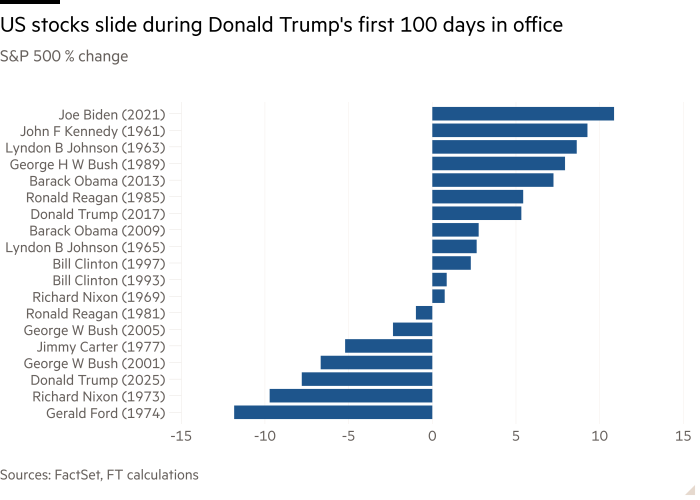‘Core’ GDP is the signal among all the noise

Unlock the Editor’s Digest for free
Roula Khalaf, Editor of the FT, selects her favourite stories in this weekly newsletter.
The writer is a professor at Harvard University and former chair of the White House Council of Economic Advisers
The US trade war is creating substantial turbulence in the global economy. It is creating even more turbulence in the statistics used to track the global economy. When reading economic data, extracting the signal from the noise is essential. Doing so is even more critical now as the impact of tariff changes take effect.
This week the US GDP statistics are going to be released and the headline is likely to be very weak. You should ignore it, as I always do, and focus instead on what could be called “core” GDP — the figures that reflect consumer spending and private investment.
Economists and market participants already know to focus on core inflation, which strips out volatile food and energy items. They do this not because they don’t care about the burdens of food and energy prices for families, but because, statistically, core inflation is a much better predictor of future overall inflation than the overall inflation number itself. In other words, core inflation is the signal. When it is high, inflation tends to be high in the future. Food and energy price changes are the noise that tends to reverse itself.
When GDP comes out, however, the headline number always attracts the lion’s share of attention. In the first half of 2022, for example, there were many debates about whether or not the US was in recession after GDP growth was reported to have contracted for two quarters in a row — falling at a 1.3 per cent annual rate (one of those negative quarters was revised away in a 2024 update).
I was not worried back then because I was focused on a statistic that grew in both quarters, averaging a 1.5 per cent annual rate in the original data release. The statistic in question has a complicated name — “final sales to private domestic purchasers” (perhaps the reason it has not caught on.) The Bureau of Economic Analysis, which produces US GDP data, added it as a memo line to their official GDP releases after I started emphasising its significance based on research I initiated when chair of the White House Council of Economic Advisers during the Obama administration.
“Final sales to private domestic purchasers” is simply the growth of personal consumption and fixed investment, including business and residential investment. These tend to be inertial, with stable readings over time, just like the core consumer price index. What it excludes: net exports, inventories and government spending.
This is important now because the trade war is having a huge transitory impact, especially on net exports and inventories, both in reality and in the difficulty of measuring the unusual movements. China’s GDP in the first quarter was boosted by an increase in exports to get ahead of the tariffs, but this is almost certainly transitory — substantially slower growth lays ahead. Conversely, shifting from domestically produced goods to imports could artificially depress US GDP growth in the first quarter in a way that reflects more shifting than underlying fundamentals.
Current estimates for US first quarter growth suggest weak and possibly even negative growth. For now, the S&P Global forecast predicts that the economy contracted at a 0.2 per cent annual rate. But its estimate for core GDP growth is 2.4 per cent, a more reliable guide to the economy’s strength in the first part of this year, although tariffs could result in significant weakening going forward.
Central banks are currently being forced to make difficult choices about whether to be more concerned about inflation or unemployment. It would be nice if they could make these choices by looking forward, but that is basically impossible given policy uncertainty. As a result, they have to rely more than ever on the data in the rear-view mirror. In doing so, we would all be better served by focusing on the underlying economic picture. Looking at core GDP is a great way to start.




